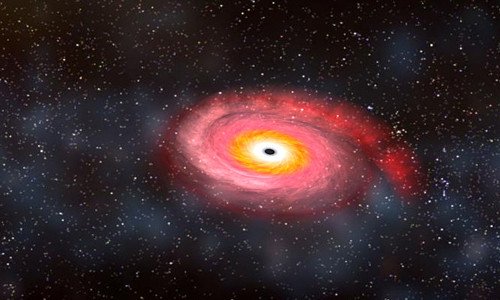The original black hole in the universe can produce gold and uranium
When swallowing neutron stars, the universe's original black holes can produce heavier elements than iron such as gold and uranium.
- Discovering new gravitational waves from two black holes collides 3 billion light-years away
- Is there a way to destroy and destroy a cosmic black hole?
In the study published in Physical Review Letters, scientists at the University of California in San Diego and Los Angeles said that when the original black hole of the universe swallowed neutron stars, it could create heavy matter.
 The original black hole in the universe can produce gold and uranium Picture 1
The original black hole in the universe can produce gold and uranium Picture 1
A black hole swallowed neutron stars.(Photo: wikimedia.)
This is in stark contrast to previous claims by scientists that fusion at the core or supernova explosions could produce elements lighter than iron, and supernova explosions. Giant crystals or the fusion of two neutron star systems can produce elements heavier than iron.
Physics professor George Fuller, co-author of the study, said that when a black hole and neutron star are combined, a form of smelter produces gold, platinum, uranium and most elements heavier than iron. He added that it is likely that these elements formed in neutron-rich environments.
Neutron stars are the most dense star in the universe. Typically, a neutron star has a mass of 1.35 to 2.1 times the mass of the Sun and it is estimated that only a scoop of neutron star's surface matter has a mass of about three billion tons, more than 900 times the mass. Giza pyramid in Egypt.
Black hole swallowed neutron stars.(Video: YouTube.)
Fuller further explained that, when neutron stars are attracted to a small black hole, it will be attracted from the inside out due to the influence of gravity. In the process of rotating, shrinking, nuclear material is released, the shrinking in the star center gradually increases. Separated material reduces pressure, heats up and has enough neutrons needed to make the element heavier than iron.
Scientists have relied on the existence of small black holes to hypothesize the formation of nuclear fuel in the universe. But many astronomers believe that such black holes were formed after the Big Bang and now lie in the dark matter of the universe.
Thep Fuller, the fact that black holes swallow neutron stars produces elements heavier than iron and nuclear fuel rarely occurs. Among the 10 new dwarf galaxies, a galaxy contains many heavy elements. Because neutron stars are very rare at the center of galaxies and dwarf galaxies, where there are many black holes.
You should read it
- For the first time in history, people witnessed two merged neutron stars creating gravitational waves
- 10 interesting facts about black holes in the universe (Part 1)
- A new discovery about the strange interaction between cosmic black holes and light
- Find out how to weigh black holes based on galaxy spiral arms
- Detecting monstrous black holes, 20 billion times larger than the sun and growing 'fast'
- Discover the most bizarre black holes in the mysterious space universe
- The discovery of a giant black hole, 70 times the mass of the Sun in the Milky Way, challenges every theory
- Discover the terrible war between two giant black holes in the universe
- Detecting an active supermassive black hole at an unprecedented distance
- Successfully creating cosmic black holes, demonstrating Hawking radiation exists
- Our galaxy contains countless invisible black holes?
- 10 interesting facts about black holes in the universe (Part 2)
May be interested

Discovering two 'super-Earths' only 12 light-years away can hide life

Do not miss the opportunity to admire the largest meteor shower of the year tonight, can be observed with the naked eye

Comet 26 km wide can collide with the Earth in 4479, erase all life

It turns out 15 'facts' about the Earth and the universe that we still believe is completely wrong

3 super computers create eclipse eclipses that help you preview the total eclipse tonight

The star is 25 times larger than the Sun, suddenly disappearing, causing astronomers to be confused






 Discover the most bizarre black holes in the mysterious space universe
Discover the most bizarre black holes in the mysterious space universe 10 interesting facts about black holes in the universe (Part 2)
10 interesting facts about black holes in the universe (Part 2) 10 interesting facts about black holes in the universe (Part 1)
10 interesting facts about black holes in the universe (Part 1) Black force - a new force in the universe, becomes even more strange
Black force - a new force in the universe, becomes even more strange The newly discovered black hole contains anomalous characteristics, challenging most astronomical theories today
The newly discovered black hole contains anomalous characteristics, challenging most astronomical theories today Astrophysics professor teaches how to jump into a black hole so it's 'safe' and possible events
Astrophysics professor teaches how to jump into a black hole so it's 'safe' and possible events